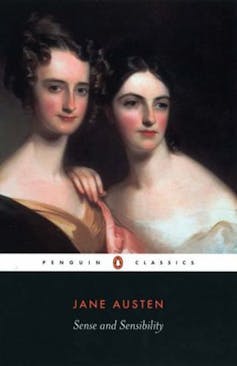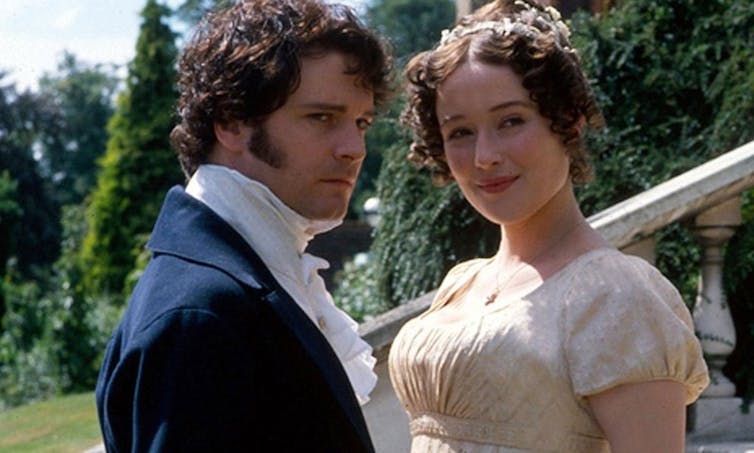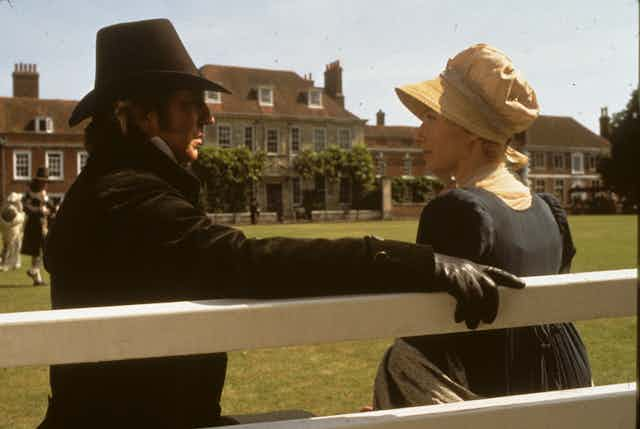It started with a throwaway line in a conversation with an Adelaide musical entrepreneur. We were planning a day of Jane Austen-related activities, and I suggested that we could use courtship as a theme for the music program. “After all,” I said, without really thinking, “they are courtship novels”. The contrarian imp who lives on my left shoulder immediately piped up, “Are you sure?”
I didn’t make up this idea. The literary scholar Sarah R. Morrison, for example, believes that in Austen’s novels “the narrative interest is concentrated in the central story of courtship – in whether or not the heroine gets her man – and the novel ends with a marriage”. I was unconsciously echoing the view of Morrison and others that day, but the more I thought about it - and listened to that contrary imp - the less sure I was.

So I went on to study each of Austen’s six novels with that thought in mind. I concluded that none of them have courtship - that is, the assiduous attention of the hero to gaining the heroine’s hand - as a central and animating theme.
I am not arguing that Austen’s novels are not in form all romances in the tradition of Shakespearean comedy. Austen may undercut the “happy ever after” ending but she never denies her readers the satisfaction of believing that her heroines end up in happy and companionate marriages. (I would also argue that this is not a trivial matter, given the nature of women’s lives 200 years ago.)
But relegating Austen to the limited field of plots about “whether or not the heroine gets her man” is misleading and contributes to a continuing habit of belittling her achievement, especially in the broader context of popular culture.
July 18 this year marks the bicentenary of Austen’s death and her celebrity continues to grow. Flinders University will host an international conference on the Immortal Austen in Adelaide in that month, where international scholars will get together to discuss the reasons for her continuing appeal.
Given that many readers and critics view her novels as “courtship narratives”, I believe it is worth examining the idea more closely. The scholar Katherine Sobba Green says that usually “a courtship novel began with the heroine’s coming out and ended with her wedding”. Firstly, then, let’s see how Austen deals with the initial stage.
The coming out

In her first novel, Northanger Abbey, Austen explicitly satirises the courtship plot by lampooning the hackneyed plots of other novels. The narrator, tongue firmly in cheek, writes that “when a young lady is to be a heroine … something must and will happen to throw a hero in her way”. Her heroine, 17-year-old Catherine Morland, daughter of a country clergyman, is taken to the fashionable town of Bath by a family friend, and meets the sophisticated Henry Tilney at an assembly, or ball. Henry is a satirist himself, and heightens Austen’s satire by making fun of the rituals of introductions, dancing and courting in which he and Catherine are engaged.
None of the other novels begins in this classic “courtship novel” fashion. Indeed, Austen’s fourth novel, Mansfield Park seems to confirm my unease with the label. Early in the novel, the worldly Mary Crawford asks her new neighbour Edmund Bertram whether or not his cousin Fanny Price (the book’s heroine) is “out”. Edmund says,
My cousin is grown up. She has the age and sense of a woman, but the outs and not outs are beyond me.
Nothing in the ensuing gossip between Mary and Edmund’s brother, Tom, about their fashionable world, where adulthood is merely a matter of social form, contradicts this statement. It stands like a manifesto for the novel: Fanny is not of that world. Austen keeps her apart and imbues her with a completely separate sense of values.
Still, the “coming out” does allow the heroine to encounter the hero. In Pride and Prejudice, Elizabeth Bennet meets Mr Darcy at the local assembly (or ball) where he pointedly doesn’t dance with her.

When she knows him better and thinks she doesn’t care, she teases him with that fact. He responds, stiffly, “I had not at that time the honour of knowing any lady in the assembly beyond my own party.” Elizabeth won’t let him get away with that: “True;” she says, “and nobody can ever be introduced in a ball room,” drawing attention to his failure to act the part of the courtly male.

Only one of Austen’s other heroines meets the man she falls in love with during the course of the novel, and that’s Marianne Dashwood, the “co-heroine” of Sense and Sensibility. Like everything about the brief, doomed association of Marianne and Willoughby, their meeting is terribly romantic and slightly improper. “Running with all possible speed down the steep side of the hill”, Marianne falls over and hurts her ankle.
The outrageously handsome Willoughby happens to be passing, picks her up and carries her home. But he is not the hero: she will not marry him. They fall in love, but Willoughby abandons her to marry for money.
Otherwise, the heroines have known the heroes before the action begins, usually through prosaic family connections. Sometimes they are even related, undermining further the classic contours of the courtship plot.
The Courtship
In Northanger Abbey, there is certainly a lot of courting. Henry Tilney’s behaviour to Catherine, though, is a conscious parody of courtship. And it evaporates once his father starts courting Catherine on his behalf, thinking she is potentially a rich wife for his son. At that stage, Henry abandons his playful behaviour, embarrassed into sober sincerity by his father’s ill-judged blandishments.
Even in Sense and Sensibility, Austen’s second novel, the question of whether Willoughby is actually courting Marianne is left uncertain. We are exposed to various opinions through the novel, – Willoughby is in love with Marianne; Willoughby never loved Marianne; Willoughby is a perfidious villain - Willoughby is a weak and vain young man who nevertheless has strong feelings and is to be pitied because he has lost the woman he loves.
Sense and Sensibility’s emotional intensity lies mainly in the devotion displayed towards Marianne by her sister Elinor. The engine of the plot has as much to do with the sisters’ economic deprivation as their marriage prospects.

In Emma Frank Churchill, the adopted son of a wealthy family, only pretends to court the heroine Emma Woodhouse because he has a secret. Mr Knightley, likewise, doesn’t court Emma till about five minutes before he proposes: it doesn’t occur to him to do so. And what does Emma say?
Just what she ought, of course. A lady always does. She said enough to show there need not be despair – and to invite him to say more himself.
Emma’s habitual assertiveness makes this formulation startling – it’s odd that she becomes suddenly so coquettish, inviting the usually self-assured and forthright Mr Knightley to act the anxious suitor, so much out of character for him. Perhaps that’s a sign of Austen’s discomfort with the form, causing her to strike, for once, a false note. Or perhaps Emma was enjoying her moment of power over him.
The main courtship in Emma is the heroine’s condescending attention to her young and impressionable friend Harriet Smith. The young farmer Robert Martin courts Harriet too, in the background. If their story had been the main plot of the novel it would indeed be a courtship novel, but instead it is a mystery novel, a bildungsroman, a romantic comedy, a novel of social realism – everything but.
In Pride and Prejudice, Mr Darcy is interested in Elizabeth, but he tries his best not to court her - “In vain have I struggled,” he tells her, in one of the most famous proposals in the history of literature. Despite his struggle, he does eventually court Elizabeth, because the strength of his feelings overcomes his scruples.
After she rejects him, he once again tries not to court her, this time out of courtesy. The successful courtship takes place during an afternoon walk towards the end of the novel, and consists of the following speech:
You are too generous to trifle with me. If your feelings are still what they were last April, tell me so at once. My affections and wishes are unchanged, but one word from you will silence me on this subject for ever.
In Mansfield Park, the heroine, Fanny, watches the hero, Edmund, court another woman, while being courted by another man she has no interest in marrying.

In Persuasion, Austen’s last novel, the heroine Anne Elliot is in much the same situation. We know from the chapters of Persuasion that survive from her first draft, (which she later replaced) that Mr Elliot’s unwelcome courtship of Anne was originally to be the hinge on which the love plot turned.
Austen thought better of this clunky plot device and replaced it with the magnificent scene at the White Hart Inn, where the hero Captain Wentworth overhears a conversation between Anne and one of his friends that convinces him that she still loves him. This scene, setting the lovers’ reconciliation in the middle of the oblivious bustle of other people’s activity, takes Persuasion even further away from the traditions of the courtship novel.
In the early novels, Northanger Abbey and Sense and Sensibility, Austen is playing with the form, satirising courtship behaviour and romantic meetings. As Northanger Abbey ends, Austen quips,
I leave it to be settled, by whomsoever it may concern, whether the tendency of this work be altogether to recommend parental tyranny, or reward filial disobedience.
In the later novels, the activity of courtship between the couples who will eventually marry hardly figures at all. In Mansfield Park, for instance, the narrator blithely cheats the reader of the satisfactions of a detailed description of Edmund’s eventual courtship of Fanny:
I purposely abstain from dates on this occasion, that every one may be at liberty to fix their own, aware that the cure of unconquerable passions, and the transfer of unchanging attachments, must vary much as to time in different people.
The Wedding
Weddings are clearly the least interesting part of these novels: at the end of Northanger Abbey,
Henry and Catherine were married, the bells rang and every body smiled.

Emma’s wedding “was very much like other weddings, where the parties have no taste for finery or parade”. The pretentious parson’s wife Mrs Elton’s scorn at the lack of “white satin” and “lace veils”, perhaps, might give pause to those who think of Austen mainly in terms of Regency fashion.
Perhaps I’m splitting hairs. As far as the plots are concerned, the novels are all in the romantic comedy tradition, where young people find a spouse at the end of the story. But this is not in the sense of merely “catching a husband”.
It is finding the best possible mate for the best possible life, and that involves much more than just making a match. To call them courtship novels is too reductive.
The critic Charles H. Hinnant seems to agree with me: he attributes the “popular appeal of the classic Austenian romance paradigms” to the uncertainty of the “outcome of the lover’s address” - the absence of the courtly assumption of ladies’ coquettishness and the routine pretence of the courting lover that characterizes the classic courtship plot.
Why does it matter?
Has Austen’s very popularity started to undermine her stature, as Camilla Nelson claims? Andrew Davies did not help with his imaginative fleshing-out of the narrative in his 1995 television screenplay for Pride and Prejudice. The series cemented Austen’s reputation with a whole generation as the author of simple Cinderella-style love stories which can be comprehended without actually reading a word of her novels.

Recently a friend described Austen’s novels to me as “perfect escapism”. I protested but she had a cogent argument: escapism doesn’t mean vapidity. Susan Chira made a similar point in the New York Times: “I wanted escape, but I needed moral resonance”.
Austen’s novels are an escape from an irrational and threatening world, yes, but the world they depict is no fairytale. For me, their appeal is more to do with how they are told than with what happens. The narrator’s witty, mature presence - her voice - brings us confidently through her tales of characters often living near the edge of poverty or unhappiness to the “happy ending” - happy, of course, only for a select few characters. (And this voice is the very thing that is almost impossible to convey in a film.)
Camilla Nelson says that Austen was not a feminist. I agree. She was more revolutionary than that. She assumed for her central female characters moral agency without reference to men. Not even the 17-year-old Catherine Morland in Northanger Abbey thinks to ask her father or her brother how to behave. She only asks the advice of her host, Mr Allen,
to ease her mind, and ascertain by the opinion of an unprejudiced person what her own conduct had really been.
And in Sense and Sensibility, Elinor Dashwood, at 19, is by far the most mature person. It is taken absolutely for granted that these women are, or have the capacity to become, competent moral agents drawing only on their own intelligence and experience - and like many things taken for granted, it is easy to miss this startling fact.
I increasingly believe that this, as much as the sense of romantic fulfilment they provide, is the secret of her novels’ enduring appeal, and the reason that bicentenary of her death is being celebrated worldwide with exhibitions, conferences and festivals.
Gillian Dooley is the co-convenor of Immortal Austen, an international conference to be held in Adelaide in July. Her article ‘The Bells Rang and Every body Smiled’ was published in Persuasions on Austen’s birthday last year.

